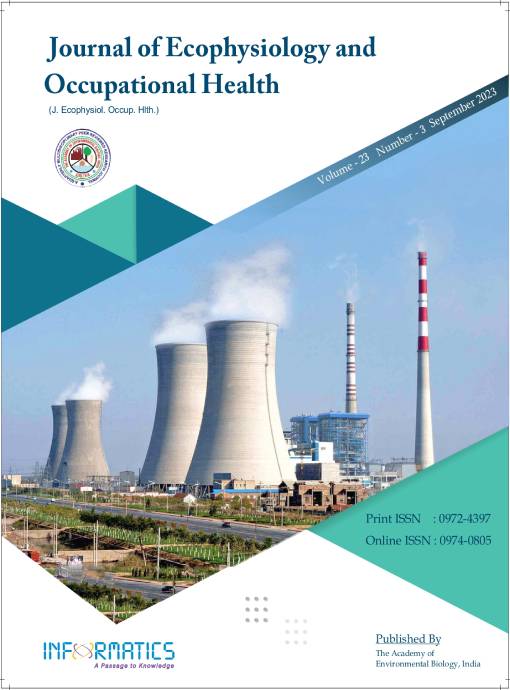Distillery Effluent Melanoidin Decolorization Induced by a Yeast Strain Candida tropicalis (Y-2)
DOI:
https://doi.org/10.18311/jeoh/2023/34581Keywords:
Decolorization, Melanoidin, Medium, Novel Yeast, OptimizationAbstract
Molasses is used in the manufacturing of ethanol at sugarcane distilleries, which also produces a significant volume of effluent with melanoidin pigment and high BOD, COD, and pH. Melanoidin is a dark brown pigment that may be treated before disposal since it has a number of harmful consequences. This study’s objective was to identify possible melanoidin pigment-decolorizing yeast from natural resources and optimize it for various physiological, chemical, and dietary factors. From the various samples taken from the neighbouring distillery site, a total of 15 yeasts were isolated. Candida tropicalis (Y-2) was the name of the yeast strain that had the most colour decolorization. Within 32 hours of incubation, this strain of yeast displayed maximal decolorization (83%) at 35°C with 0.5% glucose, 0.5% peptone, 0.05% MgSO4, and 0.01% KH2PO4 pH-5. This yeast displayed maximal decolorization in the shortest amount of time while using the least quantity of carbon and nitrogen sources. This yeast strain may be used on an industrial scale to decolorize melanoidin since it is exceedingly successful. This is the first investigation of this unique strain of yeast that decolorizes spent wash.
Downloads
Metrics
Downloads
Published
How to Cite
Issue
Section
License
Copyright (c) 2023 Ajad Patel, Ranjan Singh, Tuhina Verma, Vijay Shukla, Rajeeva Gaur

This work is licensed under a Creative Commons Attribution 4.0 International License.
Accepted 2023-08-23
Published 2023-09-19
References
Naik N, Jagadeesh KS, Noolvi MN. Enhanced degradation of melanoidin and caramel in biomethanated distillery spent wash by microorganisms isolated from mangroves. Iranian (Iranica) Journal of Energy and Environment. 2010; 1(4).
Wedzicha BL, Kaputo MT. Melanoidins from glucose and glycine: Composition, characteristics and reactivity towards sulphite ion. Food Chemistry. 1992; 43(5):359-67. https://doi. org/10.1016/0308-8146(92)90308-O DOI: https://doi.org/10.1016/0308-8146(92)90308-O
Dahiya J, Singh D, Nigam P. Decolourisation of synthetic and spentwash melanoidins using the white-rot fungus Phanerochaete chrysosporium JAG-40. Bioresource Technology. 2001; 78(1):95- 8. https://doi.org/10.1016/S0960-8524(00)00119-X DOI: https://doi.org/10.1016/S0960-8524(00)00119-X
Chandra R, Bhargava RN, Rai V. Melanoidins as major colourant in sugarcane molasses-based distillery effluent and its degradation. Bioresource Technology. 2008; 99(11):4648-60. https://doi.org/10.1016/j.biortech.2007.09.057 DOI: https://doi.org/10.1016/j.biortech.2007.09.057
Peña M, Coca M, González G, Rioja R, Garcıa MT. Chemical oxidation of wastewater from molasses fermentation with ozone. Chemosphere. 2003; 51(9):893-900. https://doi.org/10.1016/ S0045-6535(03)00159-0 DOI: https://doi.org/10.1016/S0045-6535(03)00159-0
Mohana S, Desai C, Madamwar D. Biodegradation and decolourization of anaerobically treated distillery spent wash by a novel bacterial consortium. Bioresource Technology. 2007; 98(2):333-9. https://doi.org/10.1016/j.biortech.2005.12.024 DOI: https://doi.org/10.1016/j.biortech.2005.12.024
Moosvi S, Keharia H, Madamwar D. Decolourization of textile dye Reactive Violet 5 by a newly isolated bacterial consortium RVM 11.1. World Journal of Microbiology and Biotechnology. 2005; 21:667-72. https://doi.org/10.1007/s11274-004-3612-3 DOI: https://doi.org/10.1007/s11274-004-3612-3
Ohmomo S, Kaneko Y, Sirianuntapiboon S, Somchai P, Atthasampunna P, Nakamura I. Decolorization of molasses wastewater by a thermophilic strain, Aspergillus fumigatus G-2- 6. Agricultural and Biological Chemistry. 1987; 51(12):3339-46. https://doi.org/10.1080/00021369.1987.10868588 DOI: https://doi.org/10.1080/00021369.1987.10868588
Nwuche CO, Ugoji EO. Effects of heavy metal pollution on the soil microbial activity. International Journal of Environmental Science and Technology. 2008; 5:409-14. https://doi.org/10.1007/ BF03326036. DOI: https://doi.org/10.1007/BF03326036
Kumar S, Viswanathan L. Production of biomass, carbon dioxide, volatile acids, and their interrelationship with decrease in chemical oxygen demand, during distillery waste treatment by bacterial strains. Enzyme and Microbial Technology. 1991; 13(2):179-87. https://doi.org/10.1016/0141-0229(91)90176-B DOI: https://doi.org/10.1016/0141-0229(91)90176-B
Jiranuntipon S, Chareonpornwattana S, Damronglerd S, Albasi C, Delia ML. Decolorization of synthetic melanoidins-containing wastewater by a bacterial consortium. Journal of Industrial Microbiology and Biotechnology. 2008; 35(11):1313-21. https:// doi.org/10.1007/s10295-008-0413-y DOI: https://doi.org/10.1007/s10295-008-0413-y
Tiwari S, Gaur R, Singh R. Decolorization of a recalcitrant organic compound (Melanoidin) by a novel thermotolerant yeast, Candida tropicalis RG-9. BMC Biotechnology. 2012; 12:1- 8. https://doi.org/10.1186/1472-6750-12-30 DOI: https://doi.org/10.1186/1472-6750-12-30
Ravikumar R, Vasanthi NS, Saravanan K. Single factorial experimental design for decolorizing anaerobically treated distillery spent wash using Cladosporium cladosporioides. International Journal of Environmental Science and Technology. 2011; 8:97-106. https://doi.org/10.1007/BF03326199 DOI: https://doi.org/10.1007/BF03326199
Tondee T, Sirianutapiboon S. Screening of melanoidin decolorization activity in yeast strain. In Int Conf Environ. 2006; 99:5511-9. https://doi.org/10.1016/j.biortech.2007.10.050 DOI: https://doi.org/10.1016/j.biortech.2007.10.050
Pazouki L, Niinemets Ü. Multi-substrate terpene synthases: Their occurrence and physiological significance. Frontiers in Plant Science. 2016; 7:1019. https://doi.org/10.3389/fpls.2016.01019 DOI: https://doi.org/10.3389/fpls.2016.01019
Ohmomo S, Kainuma M, Kamimura K, Sirianuntapiboon S, Aoshima I, Atthasampunna P. Adsorption of melanoidin to the mycelia of Aspergillus oryzae Y-2-32. Agricultural and Biological Chemistry. 1988; 52(2):381-6. https://doi.org/10.1080/00021369. 1988.10868685
Çetin D, Dönmez G. Decolorization of reactive dyes by mixed cultures isolated from textile effluent under anaerobic conditions. Enzyme and Microbial Technology. 2006; 38(7):926-30. https:// doi.org/10.1016/j.enzmictec.2005.08.020 DOI: https://doi.org/10.1016/j.enzmictec.2005.08.020
Sirianuntapiboon S, Phothilangka P, Ohmomo S. Decolorization of molasses wastewater by a strain No. BP103 of acetogenic bacteria. Bioresource Technology. 2004. 92(1):31-9. https://doi. org/10.1016/j.biortech.2003.07.010 DOI: https://doi.org/10.1016/j.biortech.2003.07.010
Adikane HV, Dange MN, Selvakumari K. Optimization of anaerobically digested distillery molasses spent wash decolorization using soil as inoculum in the absence of additional carbon and nitrogen source. Bioresource Technology. 2006; 97(16):2131-5. https://doi.org/10.1016/j.biortech.2005.10.011 DOI: https://doi.org/10.1016/j.biortech.2005.10.011
Sirianuntapiboon S, Zohsalam P, Ohmomo S. Decolorization of molasses wastewater by Citeromyces sp. WR-43-6. Process Biochemistry. 2004; 39(8):917-24. https://doi.org/10.1016/ S0032-9592(03)00199-7 DOI: https://doi.org/10.1016/S0032-9592(03)00199-7
Kumar P, Chandra R. Decolourisation and detoxification of synthetic molasses melanoidins by individual and mixed cultures of Bacillus spp. Bioresource Technology. 2006; 97(16):2096-102. https://doi.org/10.1016/j.biortech.2005.10.012 DOI: https://doi.org/10.1016/j.biortech.2005.10.012
Kirk TK, Schultz E, Connors WJ, Lorenz LF, Zeikus JG. Influence of culture parameters on lignin metabolism by Phanerochaete chrysosporium. Archives of Microbiology. 1978; 117:277-85. https://doi.org/10.1007/BF00738547 DOI: https://doi.org/10.1007/BF00738547
Miranda MP, Benito GG, San Cristobal N, Nieto CH. Color elimination from molasses wastewater by Aspergillus niger. Bioresource Technology. 1996; 57(3):229-35. https://doi. org/10.1016/S0960-8524(96)00048-X DOI: https://doi.org/10.1016/S0960-8524(96)00048-X
Shayegan J, Pazouki M, Afshari A. Continuous decolorization of anaerobically digested distillery wastewater. Process Biochemistry. 2005; 40(3-4):1323-9. https://doi.org/10.1016/j. procbio.2004.06.009 DOI: https://doi.org/10.1016/j.procbio.2004.06.009
Angayarkanni J, Palaniswamy M, Sawminathan K. Biotreatment of distillery effluent using Aspergillus niveus. Bulletin of Environmental Contamination and Toxicology. 2003; 70:268. https://doi.org/10.1007/s00128-002-0187-2 DOI: https://doi.org/10.1007/s00128-002-0187-2
Krzywonos M. Decolorization of sugar beet distillery effluent using mixed cultures of bacteria of the genus Bacillus. African Journal of Biotechnology. 2012; 11(14):3464-75. https://doi. org/10.5897/AJB11.3029 DOI: https://doi.org/10.5897/AJB11.3029
Yadav S, Chandra R. Biodegradation of organic compounds of Molasses Melanoidin (MM) from Biomethanated Distillery Spent Wash (BMDS) during the decolourisation by a potential bacterial consortium. Biodegradation. 2012; 23(4):609-20. https://doi.org/10.1007/s10532-012-9537-x DOI: https://doi.org/10.1007/s10532-012-9537-x
 Ajad Patel
Ajad Patel








